[one_half padding=”0 0 0 0px”]
Smith & Wesson Performance Center 686
[/one_half]
[one_half_last padding=”0 0 0 0px”]
[/one_half_last]
[one_half]
Specifications
- Manufacturer: Smith & Wesson
- Model: 686 Plus (Performance Center)
- Frame Size: L-Frame
- Caliber: .357 Magnum / .38 Special +P
- Action: Double Action / Singe Action
- Capacity: 7 Rounds
- Barrel Length: 2.5 inches
- Front Sight: Red Ramp
- Rear Sight: Adjustable
- Overall Length: 7.5 inches
- Grip: Wood
- Weight: 35 ounces
- Barrel Material: Stainless Steel
- Cylinder Material: Stainless Steel
- Frame Material: Stainless Steel
- Finish: Matte Glass Bead Blast
- M.S.R.P.: $1,089[/one_half]
[one_half_last]
[/one_half_last]
Snubby revolvers have been a mainstay of concealed carry since the introduction of the original Smith & Wesson “Chief’s Special” in 1950. Although immensely practical as a defensive handgun, the classic snubby revolver has always suffered from a few serious drawbacks–most notably, having a limited ammo capacity, and being difficult to shoot well. However, a little bit of modern technology and a lot of meticulous attention from the talented gunsmiths in the Smith and Wesson Performance Center have elevated the classic snubby revolver to a new level.
This Performance Center 686 Plus firmly straddles the line between old school and modern design. At its core, this revolver is a stainless-steel double-action revolver with wood grips and iron sights. But this 686 Plus has a capacity of seven rounds in the same diameter cylinder that used to only fit six. Combine that increased capacity with the magic of some fine-tuning in the Performance Center, and you have a thoroughly modern defensive revolver.
Better Features
Of course, this PC 686 Plus is considerably larger than the classic 5-shot snubby revolver. At 7.5 inches long and nearly 35 ounces in weight, this gun is not suited for pocket carry. However, if you are willing to carry a larger revolver, the size increase pays huge dividends. The 686 Plus has good-sized wood stocks that will fit even large hands. And, the larger “L-frame” makes for a more comfortable grip and trigger reach than small-frame snubbies.
Since 1996, Smith & Wesson has offered L-frame .357 Magnum revolvers in six or seven shot capacities. Although the cylinder diameter is the same, modern advances in materials technology have allowed the cylinder walls to be thinned enough to fit an extra round. While some traditionalists still prefer the traditional 6- round L-frame, when it comes to a defensive revolver, the extra round is a huge benefit. By comparison, the 686 Plus has 40% more capacity than a typical small-frame snub nose revolver. With seven rounds on tap, the 686 Plus is approaching the capacity of most single-stack semi-auto pistols suitable for concealed carry. All of a sudden, carrying a revolver instead of a semi-auto doesn’t seem like so much of a compromise in ammunition capacity.
Perhaps the most distinguishing feature of this particular 686 Plus is the extra attention from Smith & Wesson’s talented Performance Center gunsmiths. Performance Center guns are Smith & Wesson’s best products, designed for their most demanding customers. This translates into a high level of fit and finish, but more importantly, a well-tuned action. This type of refinement is particularly valuable in a double-action revolver, which can have a long and heavy trigger. The Performance Center tuning produces a light and smooth trigger pull. Together with the smaller required rotation of the 7-shot cylinder, this 686 Plus trigger is a delight. I have experienced better revolver triggers on finicky target guns, but the Performance Center guns strike a proper balance between a light trigger and rock solid reliability.
The Performance Center snub is adorned with a few distinguishing cosmetic features, like the unfluted cylinder and the slab-side barrel. The gun also sports an engraved Performance Center logo on the left side-plate, and a laser etching on the barrel shroud. Both give the revolver a unique custom appearance.
Better Performance
Shooting a snubby revolver is usually a challenge. Shooting a .357 Magnum snubby revolver is always a challenge. I have mostly given up on shooting small-frame Magnums, unless I am required to do so. It can be done, but I am not a fan.
Shooting .357 Magnum rounds from an L-frame snubby revolver, however, is a far better experience. The additional weight, along with the larger frame and grips, make a big difference. Although shooting Magnums will still definitely get your attention, the gun is manageable with a proper crush grip. Regardless, a snubby Magnum revolver is not well suited to anyone who is recoil sensitive. At least you always have the option of shooting .38 Special +P, if desired.
Even with the short barrel, this 686 Plus offers strong ballistic performance with Magnum loads. I tested four different brands of premium defensive ammo, and all produced average muzzle velocity in excess of 1,100 feet per second. At these velocities, you should be able to expect excellent performance from modern expanding jacketed hollow point bullets.
The 686 Plus is also exceptionally accurate for snubby. I had no problem with drilling out the x-ring of a standard NRA target at 7 yards. Similarly, a steel plate rack at 10 yards can be cleared with no problem. Even at 25 yards, head shots on a silhouette are easy to come by. This is due in part to the revolver’s excellent adjustable rear sight, and high visibility red ramp front sight.
This revolver is also set up for using moonclips, which hold all seven rounds as a single unit for ease of loading and unloading. A discussion of the pros and cons of moonclips is unfortunately beyond the scope of this article. The utility of moonclips in a defensive revolver is open to debate–but there is no drawback to having the cylinder cut to accept them. With this 686 Plus, you have the option of using moonclips or not.
Better Snubby
While not really fair to compare this gun to a traditional small-frame snubby revolver, that is a natural comparison. The PC 686 Plus snub is much easier to shoot, more accurate, and more powerful. With seven rounds of .357 Magnum on tap, this gun compares favorably with the firepower of many semi-automatic handguns. If you are a “revolver guy,” and want to carry a wheel gun, you don’t have to feel under gunned with this 686 Plus.
Prices of quality revolvers have been creeping up in recent years. A standard 686 Plus snubby retails for $849. Performance Center guns, however, always command a premium price. The PC version of the 686 Plus snub retails for $1,089. For the extra $240, you get wood grips, different sights, a cylinder cut for moonclips, and a hand tuned action. In my opinion, the extra cash is very well spent. As with any Smith & Wesson firearm, the 686 Plus is covered with a lifetime service policy, and their customer service is some of the best in the business.
Carrying a snub nose revolver is always a compromise of some kind. The Performance Center 686 Plus addresses some of these shortcomings with additional capacity and ease of use. Unfortunately, that additional capability comes in a package much larger than the traditional snubby revolver. If you can cope with the additional size and weight, this is a remarkable carry gun. A blend of old and new technology, with some custom craftsmanship thrown in, makes this 686 Plus a better snubby, and a great choice for carry.
The author would like to thank Winchester (www.winchester.com), Federal (www.federal premium.com), and Hornady (www.hornady.com), for providing ammunition for testing. All shooting was done at the Southern Exposure training facility in Lakeland, Florida (www.southernexposuretraining.com).
[one_half]
[/one_half][one_half_last]
[/one_half_last][one_half]
[/one_half][one_half_last]
[/one_half_last][one_half]
[/one_half][one_half_last]
[/one_half_last]


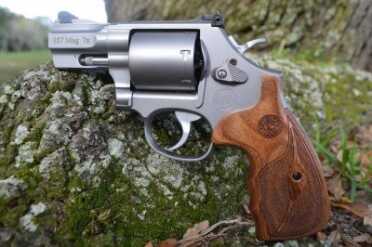
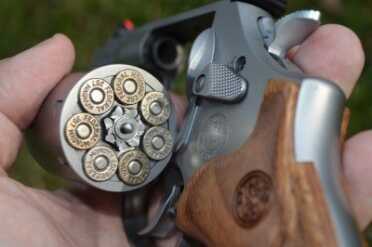

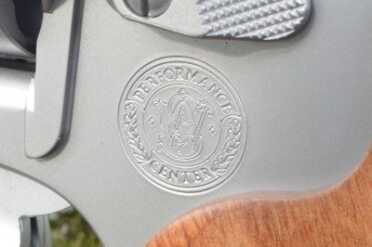
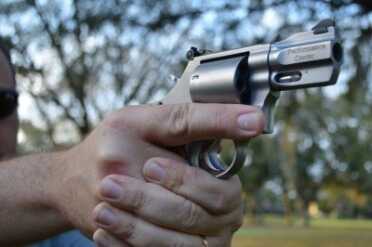
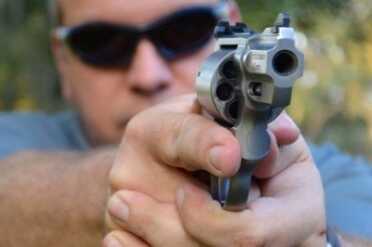

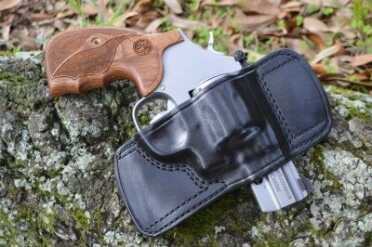
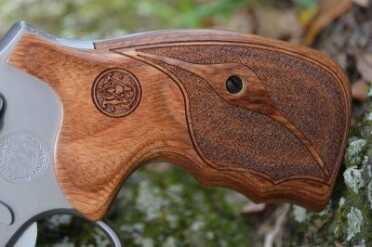

I own a 686 PC, great revolver.
I bought the S&W 686 – 7 shot, identical to the weapon in this article. The problem is when shooting 357 mag ammo the gun gets hot and the moon clips and / or speed loaders don’t work, only way to reload is one at a time. The cylinder is already chamfered so can’t guess as to the problem. Anyone have any thoughts?
So I finally got it back yesterday. Notes say only “replaced firing pin.” They also either replaced the cylinder or refinished it in a completely different color that doesn’t match the frame and barrel. Thanks for giving me a 2tone gun I never wanted S&W!! They also threw out the notes I had in the box from the last repair. No idea if it will actually work now, but I’lol prob end up sending it back before I fire it.
I wanted to add an update. I spoke with S&W today who told me they bad to replace the firing pin. The first time it went back they replaced the crane, arm, and some miscellaneous parts. I still haven’t even put 100 rds through it and have never gone through an entire chamber of ammo without an issue. Maybe their vaunted “Performance Center” should actually test their guns. My buddy just bought one of their 1911s and it feels like their is no spring in the thumb safety. It moves but doesn’t click into place. So much for quality craftsmanship.
Kinda reminds me of an ax I own that I as told once belonged to George Washington. Of course the handle had been replaced several times, but the head only once.
This is my third article (I’m new to Guns America) and so far all three quickly become derailed with foolish, off topic, narrow minded individuals. Dear Abby would be better suited for your oh so keen grammer, spelling skills and concerns.
I digress.
I think this S&W .357 7 rounder is sharp looking. The price, however, is restrictive for me. I inherited a S&W .38 special Airweight J frame. Being a 50+ year old novice and shooting it for the first time about a year ago, I struggled with the second load compliments of the smaller wooden stock grips (the recoil was pounding my palm). I replaced with Hogue grips and it changed the whole dynamics of both comfortability and accuracy.
So to agree with some and disagree with others (shocking when blogging), it is scientifically and physically impossible to tightly pattern a 2″ – 2.5″ barreled revolver against a 5″ – 6″ same caliber revolver. If they were equal in performance and or accuracy, you would see short barrels in competitions. Right? Liken it to an 18″ vs a 32″ barreled shotgun. Scattered vs patterned. Okay, both have patterns, but the longer is obviously better suited for accuracy. Snubs are great conceal and do not run the risk of malfunction (compared to a semi-auto). Pros and con’s to everything.
My hip carry is a S&W .40 Shield. My ankle is my Fathers S&W .38 spl. My side-dancing point is I feel Smith & Wesson produces an excellent product. My families lives depend upon it.
And to you rightous spell checking, grammar correctors please comprehend that there are countless levels of educated people. So for those who are not as skilled, cut them some slack. Maybe focus that energy by volunteering at a local elementary school. You never know, you learn something as well.
I hope this find all well and safe.
All I know is with my 2.5 686, I can consistently hit a target the size of a softball at 20 and 30 yards. That works pretty well for me. The only issue is that accuracy starts getting a little bouncy after about 14 rounds have went through the revolver. I absolutely love my L Frame 686 357.
I bought one in September. Total POS. the trigger would hang up every other cylinder movement and a ton of light primer strikes. Sent it in and SW replaced a bunch of parts. Took it to the range and I’m still having a ton of light primer strikes and the trigger became worse after the repair. FYI I also own a 686 Pro Series that is far better.
I have a model ss model 60 -10 , 5 shot 357 with a 3 1/2 in barrel ..it is the best revolver I ever had of hundreds … I have a carry rounded grip that came with it that makes it very flat and a full sized pachmeyer grip for usual use on the farm …real acurate , easy to carry and I am not in crime or law enforcement so I don’t need more than 5 as far as I can tell ever to protect and get out of a bind . I want 357 or better to protect , rather have a 41 mag …but this looks like a great gun to me ( I would love to have one but would buy the 4 inch version ) and it could easily replace a 45 1911 full or medium size one for someone that anticipates a prolonged firefight ( rare )..I will never sell my model 60 it is the best protection gun I ever had carry it all the time unless I have my cheapo taurus 5 shot snub 38 , the taurus is cheap effective and so small I forget I have it
I WAS TAUGHT (MANY YEARS AGO AT THE ACADEMY) THAT A SEMI-AUTO HANDGUN IS A “PISTOL” . BUT, I ALSO KNOW THAT THE “PISTOLEROS” OF THE OLD WEST DID NOT, FOR THE MOST PART, CARRY SEMI-AUTO HANDGUNS. AT LEAST NOT UNTIL THE VERY END OF THE COWBOY ERA. PO-TAY-TO, PO-TAH-TO, I GUESS. I DO LIKE THE BIG SMITH’S. I HAVE OWNED SEVERAL, INCLUDING A 4″ 686 & A 4″ 586 IN THE 80’S, AND A 3″ MAGNA-PORTED 629 WITH UNFLUITED CYLINDER THAT HAD BEEN TUNED BY THE S&W PC. IT WAS A BEAR TO SHOOT OFTEN, BUT IT WAS SWEET. ALAS, I OWN NOT ONE S&W SINCE THE BANGOR-PUNTA DAYS. BUT, I WOULD LIKE TO FIND ONE OF THESE ON SALE SOMEWHERE, OR SECOND HAND.
Just bought the 627 model (8 rounds) 357 Mag. also from S & W’s Performance Center, really nice weapon.
My revolver looks identical to the 686 but mine is a 627 – 8 shot. I went to a black Hogue finger grip, I do extremely well with it.
I will have a 627 someday.
That’s an all time favorite I’ve been looking at for a while.
Real nice design & holds 8.
I will not buy a later model Smith & Wesson since they put that little hole on the side to lock it. I bought an older model S&W a couple of years ago second hand because it doesn’t have a lock on it. Since they folded under pressure from Bill Clinton when he was pres., I will not buy any gun from S & W anymore! I’ve got a long memory!
S&W is under a different ownership than it was when Clinton was president. You may have a long memory but it could use a little updating.
I don’t find the trigger lock to be a distractor. It is a safety tool to ensure that the pistol cannot be found and fired by kids or someone not familiar with revolvers. In other words it puts the responsibility of a safe revolver in the hands of the owner. Don’t like the key? Throw it away and ignore the small insignificant key hole. The revolver will function just fine.
S&W makes some of the finest revolvers in the word and if they want to add a safety feature intended for the purpose of making sure accidental deaths can be prevented I say good for them.
Interesting article.
Wow–even as a guy that much prefers semis for CCW, this Snub-686 definitely (as the author states) at the very least makes it a candidate for consideration. I would personally, however, still go with either a Taurus 905 or new Ruger LCP 9mm solely because I have lots of 9mm on hand and do not wish to start procurement of another caliber–Obviously the holdback with the 9mm snubs are limited capacity (5 as compared to the 686’s 7 rounds which is significant to some).
One thing a a semi-guy I am not sure on–why would one consider moonclips for the 686 instead of the speedloaders…? If I’m reading correctly the custom work on the chambers needed for moonclips is arguably money ‘poorly’ spent when readily available speedloaders exists? Is this correct or did I miss a point or two…?
-Cheers
If you can find a speed loader for the 7 round 686 or the 8 round 627 reply to this with a link. I’ve been looking and have had no luck.
I got mine at Brownell’s.
They are available. Google for the HKS 587-A loader.
I found some at Midway USA.
I bought some from Midway USA which I also Goggled.
Hi All,
Can a laser sight or flash light be added to this?
I’m kinda new to firearms… can this be blackened aftermarket by a gun shop?
Thanks Much.
That’s a nice looking revolver, but costing north of $1K it should be. I’d be more interested if it was made with a deep blue finish. The bead blasted SS doesn’t appeal to me at all. As another commenter said, this finish looks like a piece of aluminum.
What most folk think is a bead blasted or sand blasted finish is actually acid dipped. Too hard to get a really even surface with blasting media.
Good Gun. Good article
Especially the hard gray case feature (OK just kidding on that).
My North American Arms .22 Magnum is the best pocket snubby I ever carried.
Five shots single action and light as a feather, but I still would consider a .357 magnum because it’s a fantastic round for self defense. Maybe a Taurus or Ruger. Or maybe Charter only I don’t know enough about their reliability.
“Since 1996, Smith & Wesson has offered L-frame .357 Magnum revolvers in six or seven shot capacities.” I bought my first 686 (with a 6″bbl) in, I believe, 1982 or 1983. It has always been a nail-driver of a revolver/pistol/handgun/smoke-pole, and I’ve always loved shooting it. Back then I could routinely hit a one-gallon milk jug at 100 yards, single action (and a solid two-hand grip). Nowadays, with my hands shaking bad enough to create white caps in my coffee mug … not so much. As an aside, am I the only person revolted by the sight of that action-locking key hole above the cylinder release on S&W’s revolvers? It’s been enough to make me spend my money elsewhere, more than a few times.
Of course you are right, Paul. I was trying to convey that the option of a 7 shot cylinder has been available since 1996. The standard 6-shot 686 has been around since 1980 or so. I don’t love the key hole either.
So many choices, so many variants, too many whiners and “experts.” Why not take the article for what it is…one man’s review and opinion. Before you go to ‘bitchin…buy one and after hundreds of rounds, write your own review article. I just wish I had more money so I could own all of them, instead of just the 20 or so that I do…and I conceal carry a great many of them…a large carton of holsters to match, but many just get a Mexican carry (stuck in the belt) for a quick trip to the “C” store. My bear country guns (or here on the lower Rio Grande Valley -Mexican Border of Texas) are a ported AMT .50 AE, or a Rossi 2/12″ .44 Mag., or a 2 1/2″ S&W .500….ahhh and occasionally a 2″ Taurus alloy .45 Colt. None of these hand canons get shot a lot, but enough to know I can depend on them for my life. One-shot stoppers all, but in a pinch I’ll carry a .22 short!!!
Remember the 7 “P’s”:
Proper
Prior
Planning
Prevents
Piss
Poor
Performance
to me a pistol is a semi-auto, a handgun is a revolver. i have both in 41 mag. & they are both S&W. . like the handgun better.
A handgun is any firearm that can be carried and fired with one hand. It matters not if it’s a semi or a revolver, they are both handguns, The only desigation for the differences are Revolver or pistol, the pistol is a semi auto handgun, and the Revolver is a gun with a rotating cylinder theus the term revolve.
Elmer Keith once stated that a short barreled revolver was no less accurate than one with a six inch, or longer, barrel. I ‘ve put this to the test on multiple trips to the range with my 8 round N frame Perfomance Center S&W 627’s, one with a compensated 5″ barrel and one with a 2 and 5/8″ barrel and found Keith’s assessment to be pretty much on the money.
I carry the snubby frequently. With 8 rounds and quick moon clip reloads it is just as effective as any auto loader. The 686 would be just as effective, but revolvers arn’t for everyone.
Regarding the accuracy in relation to barrel length, I wish I has saved the article and maybe someone here has it but not too long ago I read a very serious study that was quite interesting. It began agreeing that sight radius (the distance between front and rear) was much more important than the length of the barrel when aiming at a target. But! The longer the bullet is traveling down the barrel the longer and stronger it sets up a harmonic vibration which upsets the bullet in flight, adversely affecting accuracy (grouping.) In the shorter barrel the vibration is less pronounced so the bullet flies truer. No that’s NOT MY discovery, but it is interesting and I would like to know more about it if anyone has information on this study.
Lengthy article at http://www.backwoodshome.com/articles2/ayoob136.html
Nice looking piece as most everything that comes out of the performance center is. However, If I were to choose a larger .357 mag revolver for concealed carry, I’d go ahead and spring a few extra bucks for the .327 performance center revolver. 10 oz less weight and 8 rounds not 7. For now a 640 is EDC for me. Only five shots, but it is significantly narrower than other comparable snubbies (Taurus 651 for example which I also own). Hides completely away with appendix carry, and fits in my front pocket.
Like the 6+1
Whoever wrote this article, has NEVER fired a revolver!
Whoever wrote this comment should ease back on the prozac.
My name is at the top, and I assure you I have put tens of thousands of rounds through revolvers over the past 35 years. Do you have a specific concern I can address for you?
David just got kindly smacked down.
Mr. Daiker,
I’m a novice at shooting revolvers.
I shoot all other firearms pretty well. (started as a child)
I would like to ask you if there’s a “best way” to hold a revolver?
I’ve seen a SASS competitor demonstrating cupping the bottom of the grip with his weak hand palm up.
That’s the best advise I’ve received.
Russ — it is somewhat difficult to describe without pictures, but you want to use both hands on the stocks of the revolver, similar to shooting a semi-auto pistol. I do not recommend using the method you described because it does not add any stability or control to your grip. Search for some articles by Jerry Miculek on how to properly grip a revolver. Thanks for reading GunsAmerica.com.
Thank you
I am an old fart and most of my L.E.O. career I carried a revolver. I still think for civilian carry you can
not beat a revolver. This a very good one. I have this gun in a 3 in version. I even went one step
further and now carry the “N” frame version with 8 shots. With the moon clips I have as much fire
power and can reload as fast as a semi-auto. However I have the advantage of shoot 357 mag. ammo.
Both guns are very accurate and easy to shoot mag loads as this article states. Great guns !!
I have a 686 talo version and was wondering if anyone knows what difference is there to the actual tuning of the revolver?
I have the 3″ 586 Lcomp PC revolver, manufacture date 2014. I used to have a 625JM revolver which I sent into the performance center for the master revolver action package. The Lcomp’s “PC-tuned” action is several orders of magnitude below the action job I got on my 625. When I got the 625 back, I popped the side plate and it was like opening up a treasure chest. Every bearing surface I could see had the kind of mirror polish that makes it appear jet black when the light hits it just right. The feel of that trigger, man…
The 586’s action is smooth, and heavy enough for SD. I removed the sideplate on that one and had a little peek around, and nothing was polished, nothing was “hand-fitted” as far as I could tell. Everything was blued, lots of sharp corners, and the bearing surfaces were not all that smooth. The trigger wasn’t smooth and consistent from start to finish, some parts of the travel were easier than others, and you could definitely feel tiny bits of grit. Annoyingly, the ribbed mainspring it came with makes a musical ‘ding’ when the trigger is pulled.
Don’t get me wrong, I do love my 586 and the accuracy it displays has made me overlook the lackluster action, but still. A guy pays a several hundred dollar premium and gets a standard feeling action, he’s gonna feel that nagging disappointment. Hopefully I just got a bad one.
Seems like a nice gun but my 2″ 19 & 66 shoot every bit as good or better are lighter & cost me about $100-150 back when. Plus now when I carry a S&W PC revolver I carry a PD at about 25oz. & cost about $600.
A pistol is a type of handgun. Some handgun experts and dictionaries make a technical distinction that views pistols as a subset of handguns; others use the terms interchangeably. Sometimes in usage, the term “pistol” refers to a handgun having one chamber integral with the barrel, making pistols distinct from the other main type of handgun, the revolver, which has a revolving cylinder containing multiple chambers.
Pistol;
noun, 1. a short firearm intended to be held and fired with one hand.
Revolver;
noun, 1.a pistol having a revolving multichambered cylinder that allows several shots to be discharged without reloading
$1089 for a revolver? I wouldn´t pay $1089 for a semi-auto, why should I pay it for a revolver? Ruger has a 9mm snubby. It weighs 55% less, gives you 1050 fps on avg. is 40% smaller and cost 50% less. I´ll go for the Ruger 9mm snubby.
the voice of reason speaks. Thank you.
I like the Ruger 9mm too, but it also has 40% less capacity and is not as easy to shoot. Plus, using a semi-auto cartridge in a revolver has its own problems. I respect your choice, but these two guns are very different tools and both are valid choices.
I have a 40 year old 357 Mag S&W Model 19 with a 2″ barrel. A true hand canon. Out of all of the hand guns I own, it is my favorite. The 686 is a good looking gun but at twice the price of my model 19, I think I’ll stay with my 19.
I have two 66″s, a 2 1/2 ” and 4″, both great shooters. My wife took my model 19 after she shot it.
Is next!! Have had my eye on this one since it first came out. Good “compact” belt carry black bear medicine while fly fishing with a moon clip or two of Buffalobore hard cast in the fishing vest. What a beauty to my eyes.
Colt brought the Detective Special out almost 20 years before the J frames came from Smith & Wesson.
I love my S&W snubbies, but their time has gone by. Sorry guys. I can carry a modern .40 or .45 semi auto just as easy or easier, conceal it better and have more ammo of a better caliber available. If you’re not comfortable with a semi auto, by all means carry a revolver but, don’t delude yourself into thinking you have the optimum tool for the job. Reality will always trump marketing.
Do Not sell revolvers short. I don’t know how many Real gun fights you have been in, but back “in the day”
as an L.E.O. I was in several and as it happened to be, all with a snubby revolver. Back then the ammo was not
as good as what is available today. However I believe if they were dumb enough to fall down when hit back
then, they will be even dumber and fall harder today. I shoot competition every week. I see multitudes of
stove pipes, fail to eject( limp wrist) etc. ,especially with newer less experienced shooters. In a real shoot out
everything quickly goes to hell.Knowing I have a revolver in hand gives me confidence it will work as designed.
P.S. Mike. If you check statistics of REAL LIFE shootings as complied by Ed Saranow for years
the #1 most effective bullet against a human being was the 125 grain 357 mag bullet, Now a days the best 40’s, 45’s and 357 run neck in neck. So it all boils down to “shot placement”. If you like a 40 or 45 that’s fine. Caryy what you are confident and comfortable with, but do not sell the 357 short
You are absolutely correct. The .357 is the benchmark for self defense. The only thing I don’t like about it is the penetration. That’s a little dicey in a populated area.
As far as malfunctions with semis, training and practice solve 99% of the problems. Today, rather than self induced problems (such a limp wristing) almost all of the malfunctions are magazine related.
I own a 4″ 686 that I carry somedays and a 637 for concealed carry on other days. I also own a few performance center guns. Love them all. S&W makes rock solid revolvers and I would love to shoot this one. The only thing that I don’t like about it is the MSRP. If I get a chance to shoot one and love it I may get over price.
I own a 6-shot stainless steel Model 686 with a 2-3/4 inch barrel. It is my favorite gun to shoot (albeit usually with .38 Special rounds at the range), with a very smooth trigger and surprising accuracy. So I can believe that this tuned gun performs very well. But they made it ugly! The wooden grip isn’t as attractive as mine, the unfluted cylinder is hideous, the big flat-sided barrel with large type “Performance Center” and “357 Mag 7x” looks tacky. If I wanted an ugly gun I’d own a Glock or other plastic 9mm. And even without flutes (which don’t really reduce steel where it’s useful) I also wonder about the thickness and durability of the cylinder walls. I mean, they’re probably fine, but I think the issue needs to be addressed when someone increases revolver capacity without any increase in cylinder diameter — it’s not obviously a non-issue as it would be with an N-frame .357. Finally, one has to consider that for a gun this bulky and heavy a snubnosed barrel is not the most logical choice. A 4″ barrel would be no harder to holster, would have less muzzle blast, higher velocity and greater practical accuracy. Although I like my 686, I’d probably trade it for the exact same thing with a 4″ barrel.
I guess beauty is in the eye of the beholder — I love the look.
However, there is no need to be worried about the cylinder strength. S&W has been making this configuration for almost two decades without a problem. Also, S&W tells me that cylinders with an odd number of charge holes are actually stronger than those with an even number, because of the placement of the cylinder stop notches on the outside surface.
OH NO, look at that UGLY stainless steel! Looks like aluminum. I’d be a buyer if they didn’t ruin the SS.
I had a full sized 686 wheel gun that I used for target shooting back in the early nineties. Not a bad piece but the accuracy of this snubby seems embellished a bit.
I miss that six shot wheel gun but I like the Bushmaster I used it for on a trade in on more.
Must have been a Freudian slip to compensate for the “short barrel”.
Too big, too heavy. I’m 5’9″ & 155lbs with medium sized hands. My choice is the Rossi .357 stainless with a 2″ barrel. Granted, it’s only a 6-shot, but weight is manageable, and with rubber grips the gun fits and shoots “awesome.”
Additionally, for around $400, the Rossi is even more desirable for this old retiree on a fixed income! Cheers…
Good tip Norm.
That Rossi looks real nice.
I like S&W a lot, but they sure are overpriced.
That’s why I go with Ruger, Quality & affordable.
Russ, your are correct in both your logic and comments regarding quality firearms at a lower
price. However I like to think of it in terms of cars. If you are using your car to commute only,
you want certain qualities, price being one. If you buy a 6 cyl. Mustang, hey it is still a Mustang, looks
and rides great. However if you want to step up to a peppier model, there is the G.T. but it costs more
and if you Really want more then there is the Shelby GT which costs about double what the 6 cyl model
does. Think of this revolver as the Shelby model. It all boils down to personal preferences and how you
intend to use it. No matter which Mustang you choose, they will all get you from point A to point B
safely , comfortably and in style. Same with revolvers, they all go bang and send a bullet on its way.
I agree with Norm, my choice is a Taurus model 617, a 2″ snubby in .357 Mag with a 7 shot cylinder. The price is equal to the Rossi and it is stainless with rubber “ribber” grips. Very comfortable to carry and shoot.
There’s that hole in the side that makes it safer. I’ll pass
Perfect. More for me.
Longest pistol I’ve ever read about; 47.5 inches, maybe 4.75 inches.
LOL – gotta love them typos. but this 686 is so nice. That wood grip looks amazing.
LOL. Who reads a gun article and looks for typo\’s?
Folks with spelling and grammatical skills perhaps?
Must have been a Freudian slip. Compensating for a short barrel.
Not sure which article you’re reading, but this is a revolver…not a pistol.
Pistols run a range from single shot to 4 barrel derringers to revolvers to semi-automatic pistols! Basically anything that’s meant to be fired with one hand is a PISTOL. Firearms that have a place designed specifically for a second hand (like the foregrip of a rifle, aren’t technically speaking, pistols, although the new wave of Intermediate Power (aka .223 & 7.62 X 39) cartridges rifle variants with short barrels and no stocks are blurring that line.
A Pistol is ANY firearm held and fired with one hand
LOL
PISTOL;
noun, 1. a short firearm intended to be held and fired with one hand.
CASE CLOSED.
Every now and then, I find articles from people who redifine the difference between the types of handguns. My introduction to semi-auto loaders was in the US Army. Our instructor said the easiest way to look at was the M1911A1 has a reciprocating slide much akin to a piston in an auto engine. Thus, we call it a PISTol. A revolver is “self explanatory”. Right or wrong, this explanation has stayed with me forover 40 years.
Steve
Everyone is a firearms expert. Sam Colt named his invention a revolving “pistol”. But what does he know about what it should be called. Oh yes, Jeff Cooper mentioned the same thing. A revolver is also a pistol. A single shot handgun is also a pistol. Have a nice day.
Uh…before there were revolvers, there were pistols. Some were single shot, and some had multiple barrels. eventually we got
revolvers (there was even a semi-automatic REVOLVER – a webly design that self cock after firing) and of course then came along the good old semi-auto hand gun/pistol that we know and love today. Single shot, Derringer, revolver, semi-auto, they are ALL pistols.
7.5 inches.
You may think it is a typo, but it feels like a 47 inch gun.
Sorry for the gaff. I was posting this as I was wrapping up SHOT Show, so I hope this is the only one.